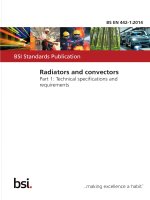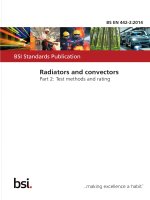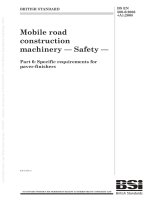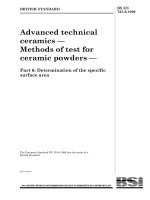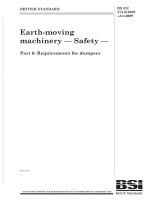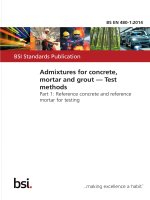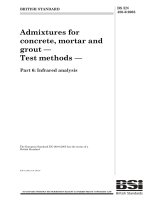Bsi bs en 13848 6 2014
Bạn đang xem bản rút gọn của tài liệu. Xem và tải ngay bản đầy đủ của tài liệu tại đây (1.21 MB, 32 trang )
BS EN 13848-6:2014
BSI Standards Publication
Railway applications — Track —
Track geometry quality
Part 6: Characterisation of track geometry
quality
BS EN 13848-6:2014
BRITISH STANDARD
National foreword
This British Standard is the UK implementation of EN 13848-6:2014.
The UK participation in its preparation was entrusted to Technical
Committee RAE/2, Railway Applications - Track.
A list of organizations represented on this committee can be
obtained on request to its secretary.
This publication does not purport to include all the necessary
provisions of a contract. Users are responsible for its correct
application.
© The British Standards Institution 2014. Published by BSI Standards
Limited 2014
ISBN 978 0 580 77862 9
ICS 93.100
Compliance with a British Standard cannot confer immunity from
legal obligations.
This British Standard was published under the authority of the
Standards Policy and Strategy Committee on 30 April 2014.
Amendments issued since publication
Date
Text affected
BS EN 13848-6:2014
EN 13848-6
EUROPEAN STANDARD
NORME EUROPÉENNE
EUROPÄISCHE NORM
March 2014
ICS 93.100
English Version
Railway applications - Track - Track geometry quality - Part 6:
Characterisation of track geometry quality
Applications ferroviaires - Voie - Qualité géométrique de la
voie - Partie 6: Caractérisation de la qualité géométrique de
la voie
Bahnanwendungen - Oberbau - Qualität der Gleisgeometrie
- Teil 6: Charakterisierung der geometrischen
Gleislagequalität
This European Standard was approved by CEN on 3 February 2014.
CEN members are bound to comply with the CEN/CENELEC Internal Regulations which stipulate the conditions for giving this European
Standard the status of a national standard without any alteration. Up-to-date lists and bibliographical references concerning such national
standards may be obtained on application to the CEN-CENELEC Management Centre or to any CEN member.
This European Standard exists in three official versions (English, French, German). A version in any other language made by translation
under the responsibility of a CEN member into its own language and notified to the CEN-CENELEC Management Centre has the same
status as the official versions.
CEN members are the national standards bodies of Austria, Belgium, Bulgaria, Croatia, Cyprus, Czech Republic, Denmark, Estonia,
Finland, Former Yugoslav Republic of Macedonia, France, Germany, Greece, Hungary, Iceland, Ireland, Italy, Latvia, Lithuania,
Luxembourg, Malta, Netherlands, Norway, Poland, Portugal, Romania, Slovakia, Slovenia, Spain, Sweden, Switzerland, Turkey and United
Kingdom.
EUROPEAN COMMITTEE FOR STANDARDIZATION
COMITÉ EUROPÉEN DE NORMALISATION
EUROPÄISCHES KOMITEE FÜR NORMUNG
CEN-CENELEC Management Centre: Avenue Marnix 17, B-1000 Brussels
© 2014 CEN
All rights of exploitation in any form and by any means reserved
worldwide for CEN national Members.
Ref. No. EN 13848-6:2014 E
BS EN 13848-6:2014
EN 13848-6:2014 (E)
Contents
Page
Foreword...................................................................................................................................................................... 4
1
Scope .............................................................................................................................................................. 5
2
Normative references .................................................................................................................................... 5
3
3.1
3.2
Terms, definitions, symbols and abbreviations ......................................................................................... 5
Terms and definitions ................................................................................................................................... 5
Symbols and abbreviations .......................................................................................................................... 5
4
4.1
4.2
4.3
4.4
Basic principles ............................................................................................................................................. 6
Introduction .................................................................................................................................................... 6
Transparency ................................................................................................................................................. 6
Complexity...................................................................................................................................................... 7
Track-vehicle interaction .............................................................................................................................. 7
5
5.1
5.2
5.3
5.4
5.4.1
5.4.2
5.4.3
5.5
5.5.1
5.5.2
5.6
Assessment of track geometry quality: state-of-the-art ............................................................................ 7
General ............................................................................................................................................................ 7
Standard deviation (SD) ................................................................................................................................ 7
Isolated defects .............................................................................................................................................. 8
Combination of various parameters ............................................................................................................ 8
Combined standard deviation (CoSD) ......................................................................................................... 8
Standard deviation of the combinations of parameters ............................................................................ 9
Point mass acceleration method (PMA) .................................................................................................... 10
Methods based on vehicle response ......................................................................................................... 10
Use of theoretical model ............................................................................................................................. 10
Use of direct measurement......................................................................................................................... 11
Power Spectral Density (PSD) .................................................................................................................... 11
6
Levels of aggregation and calculation methods ...................................................................................... 12
7
7.1
7.2
7.3
7.4
7.5
Classes of track geometry quality ............................................................................................................. 12
General .......................................................................................................................................................... 12
Description of track quality classes (TQC) ............................................................................................... 13
Values of track quality classes................................................................................................................... 14
Assignment of TQCs ................................................................................................................................... 15
Possible application of TQCs ..................................................................................................................... 15
Annex A (informative) Point mass acceleration method (PMA) ......................................................................... 17
A.1
Introduction .................................................................................................................................................. 17
A.2
Description of the PMA model.................................................................................................................... 17
A.3
Calculation of the PMA-assessment figure............................................................................................... 17
A.4
Features of the PMA method ...................................................................................................................... 18
Annex B (informative) Vehicle Response Analysis methods (VRA) .................................................................. 19
B.1
Introduction .................................................................................................................................................. 19
B.2
Determination of the assessment functions ............................................................................................. 19
B.3
Application of the assessment functions ................................................................................................. 21
B.4
Features of VRA methods ........................................................................................................................... 23
Annex C (normative) Method for calculating reference TQIs (TQIref) ................................................................. 24
C.1
Introduction .................................................................................................................................................. 24
C.2
Description of the reference method ......................................................................................................... 24
2
BS EN 13848-6:2014
EN 13848-6:2014 (E)
Annex D (informative) Method of classification of alternative TQI using the TQCs ........................................ 26
D.1
Introduction.................................................................................................................................................. 26
D.2
Description of the conversion method ..................................................................................................... 26
Bibliography.............................................................................................................................................................. 28
3
BS EN 13848-6:2014
EN 13848-6:2014 (E)
Foreword
This document (EN 13848-6:2014) has been prepared by Technical Committee CEN/TC 256 “Railway applications”,
the secretariat of which is held by DIN.
This European Standard shall be given the status of a national standard, either by publication of an identical text or
by endorsement, at the latest by September 2014, and conflicting national standards shall be withdrawn at the latest
by September 2014.
Attention is drawn to the possibility that some of the elements of this document may be the subject of patent rights.
CEN [and/or CENELEC] shall not be held responsible for identifying any or all such patent rights.
This document has been prepared under a mandate given to CEN by the European Commission and the European
Free Trade Association.
This European Standard is one of the series EN 13848 “Railway applications – Track – Track geometry quality” as
listed below:
—
Part 1: Characterisation of track geometry
—
Part 2: Measuring systems – Track recording vehicles
—
Part 3: Measuring systems – Track construction and maintenance machines
—
Part 4: Measuring systems – Manual and lightweight devices
—
Part 5: Geometric quality levels – Plain line
—
Part 6: Characterisation of track geometry quality
According to the CEN-CENELEC Internal Regulations, the national standards organizations of the following
countries are bound to implement this European Standard: Austria, Belgium, Bulgaria, Croatia, Cyprus, Czech
Republic, Denmark, Estonia, Finland, Former Yugoslav Republic of Macedonia, France, Germany, Greece, Hungary,
Iceland, Ireland, Italy, Latvia, Lithuania, Luxembourg, Malta, Netherlands, Norway, Poland, Portugal, Romania,
Slovakia, Slovenia, Spain, Sweden, Switzerland, Turkey and the United Kingdom.
4
BS EN 13848-6:2014
EN 13848-6:2014 (E)
1
Scope
This European Standard characterizes the quality of track geometry based on parameters defined in EN 13848-1
and specifies the different track geometry classes which should be considered.
This European Standard covers the following topics:
—
description of track geometry quality;
—
classification of track quality according to track geometry parameters;
—
considerations on how this classification can be used;
—
this European Standard applies to high-speed and conventional lines of 1 435 mm and wider gauge;
—
this European Standard forms an integral part of EN 13848 series.
2
Normative references
The following documents, in whole or in part, are normatively referenced in this document and are indispensable for
its application. For dated references, only the edition cited applies. For undated references, the latest edition of the
referenced document (including any amendments) applies.
EN 13848-1, Railway applications - Track - Track geometry quality - Part 1: Characterisation of track geometry
3
Terms, definitions, symbols and abbreviations
3.1 Terms and definitions
For the purposes of this document, the following terms and definitions apply.
3.1.1
re-colouring
algorithm which modifies the spectral content of a signal aimed to compensate or apply the characteristics of a
specific measuring system
Note 1 to entry:
The re-colouring is used in EN 13848 series to convert a chord measurement signal into a D1 or D2
measurement signal.
3.1.2
track quality class (TQC)
characterization of track geometry quality as a function of speed and expressed as a range of TQIs
3.1.3
track quality index (TQI)
value that characterises track geometry quality of a track section based on parameters and measuring methods
compliant with EN 13848 series
3.2 Symbols and abbreviations
For the purposes of this document, the following symbols and abbreviations apply.
5
BS EN 13848-6:2014
EN 13848-6:2014 (E)
Table 1 — Symbols and abbreviations
Symbol
Designation
Unit
AL
Alignment
ATQI
Alternative Track Quality Index
CL
Cross level
mm
CoSD
Combined standard deviation
mm
D1
Wavelength range 3 m < λ ≤ 25 m
m
D2
Wavelength range 25 m < λ ≤ 70 m
m
D3
Wavelength range 70 m < λ ≤ 150 m for longitudinal level
Wavelength range 70 m < λ ≤ 200 m for alignment
m
λ
Wavelength
m
G
Track gauge
mm
LL
Longitudinal level
mm
MBS
Multi Body System
NTQI
National Track Quality Index
PMA
Point Mass Acceleration (method)
PSD
Power Spectral Density
m /(1/m)
SD
Standard deviation
mm
SDLL
Standard deviation longitudinal level
mm
SDAL
Standard deviation alignment
mm
TQI
Track Quality Index
TQIref
Reference Track Quality Index
TQC
Track Quality Class
V
Speed
VRA
Vehicle Response Analysis (method)
mm
2
km/h
NOTE
In this European Standard, AL stands for “alignment” and is not to be confused with AL standing for “alert limit” as
defined in EN 13848–5:2008+A1:2010.
4
Basic principles
4.1 Introduction
It is necessary to standardize the way that track geometry quality is assessed in order to permit safe and costeffective railway traffic by focusing on the functional requirements of both track and vehicle.
Basic parameters for track geometry quality assessment
As track geometry measurement, vehicles present their outputs in accordance with the parameters specified in
EN 13848-1, any standardized assessment method shall be based on these parameters.
4.2 Transparency
Any algorithm for track geometry quality assessment complying with this standard shall be fully documented,
reproducible and available in the public domain.
6
BS EN 13848-6:2014
EN 13848-6:2014 (E)
4.3 Complexity
Track geometry quality should be assessed by as few TQIs as possible and the algorithm should be understandable
by the user.
4.4 Track-vehicle interaction
Track quality assessment should reflect the principles of track-vehicle interaction. For example, the track geometry
defects of the same amplitude but different wavelengths lead to different vehicle responses and the required
wavelength range will be different depending on the track-vehicle interaction parameters to be assessed.
5
Assessment of track geometry quality: state-of-the-art
5.1 General
Track geometry quality can be characterized by various TQIs according to the level of aggregation they are used for.
The TQIs described in the following sub-clauses are used by at least one of the European Railway Networks. They
represent the current state-of-the-art of description of track geometry quality.
5.2 Standard deviation (SD)
The standard deviation is one of the most commonly used TQIs by European Railway Networks. It represents the
dispersion of a signal over a given track section, in relation to the mean value of this signal over the considered
section.
N
SD =
∑ (x
i =1
i
− x) 2
N −1
where
N
is the number of values in the sample;
xi
is the current value of a signal;
x
is the mean value of a signal;
SD
NOTE 1
is the standard deviation.
Standard deviation is linked to the energy of the signal in a given wavelength range [λ1, λ2] according to the following
relationship:
λ2
SD 2 = 2 ∫ S xx (ν )dν
λ1
, where Sxx is the PSD described in 5.6 below.
SD is commonly calculated for the following parameters:
—
Longitudinal level D1;
—
Alignment D1.
It is also calculated for other parameters such as:
—
Twist;
—
Track gauge;
—
Cross level;
7
BS EN 13848-6:2014
EN 13848-6:2014 (E)
—
Longitudinal level D2;
—
Alignment D2.
For longitudinal level and alignment it is recommended to calculate SD separately for each rail. It may also be
calculated differently (for example: mean of both rails, worst or best of either rail or outer rail in curves).
Length of track section used for standard deviation has influence on the result. If comparable results are expected,
only one length should be used. Commonly, for maintenance reasons standard deviation is calculated over a length
of 200 m. It may be calculated either at fixed distances without overlap or with overlap, as a sliding standard
deviation. Calculation of standard deviation is also done over longer distances such as 1 km, an entire line or an
entire network.
NOTE 2
made.
Distinction between specific track sections, such as plain lines, stations and switches and crossings, can also be
When calculating SD for twist, track gauge and cross level attention should be paid on the possible influence of the
quasi-static part of the signals.
5.3 Isolated defects
Isolated defects may present a derailment risk; however counting the number of isolated defects exceeding a
specified threshold such as intervention limit and alert limit on a given fixed length of track can be representative of
the track geometry quality. This method is used by several European Railway Networks.
The number of isolated defects per unit of track length is commonly counted for the following parameters:
—
Longitudinal level D1;
—
Alignment D1;
—
Twist;
—
Track gauge;
—
Cross level.
It can be also counted for the following parameters:
—
Longitudinal level D2;
—
Alignment D2.
Commonly, the number of isolated defects is counted over 1 km or more. It may also be counted over 100 m or
200 m of track.
If required, distinction between specific track sections can be made, such as plain lines, stations and switches and
crossings.
Alternatively a calculation can be made to specify what percentage of a line exceeds a certain threshold level.
5.4 Combination of various parameters
5.4.1 Combined standard deviation (CoSD)
Assessment of the overall track geometry quality of a track section (200 m, 1 000 m...) can be done by a combination
of weighted standard deviations of individual geometric parameters. An example of such a TQI is given below.
8
BS EN 13848-6:2014
EN 13848-6:2014 (E)
2
2
2
CoSD = w AL . SD AL + wG SDG + wCL . SDCL + wLL SDLL
2
where
SD
standard deviation of the individual geometry parameters;
w
weighting factor of the individual geometry parameters;
with the indices:
AL
alignment, average of left and right rails;
G
track gauge;
CL
cross level;
LL
longitudinal level, average of left and right rails.
It is up to the Infrastructure Manager to determine the weighting factors, e.g. for tamping purposes the weighting
factor wG should be zero.
Another method might be to transform the standard deviations of geometry parameters or their combinations into a
dimensionless number that can be used without distinction of line category, speed range and track geometry
parameter.
5.4.2 Standard deviation of the combinations of parameters
Standard deviation for a combination of track geometry parameters can be evaluated. This is based on the
observation that the level of the combined signals may better reflect the vehicle behaviour than the individual signals.
For example, a standard deviation, over a sliding 200 m length of track, can be evaluated for the sum of alignment
and cross level in D1 as follows:
—
the alignments of left and right rails are combined into one signal, in curves by choosing the outer rail and on
tangent track by either averaging or choosing one of the two rails;
—
cross level and alignment signals are combined together by using a sign convention so that an alignment defect
to the right is added with the same sign to a cross level defect where right rail is lower than the left rail. Figure 1
shows an example of the combination of cross level Δz and alignment
—
y where the signs are both positive;
the standard deviation of the combined signals is calculated over a sliding 200 m length of track.
9
BS EN 13848-6:2014
EN 13848-6:2014 (E)
Key
1
y
reference position
= (ALright + ALleft) / 2
combination of alignment
Δz = zright - zleft
cross level
s
sum of cross level and alignment
Figure 1 — Combination of alignment and cross level
5.4.3 Point mass acceleration method (PMA)
The PMA method is based on the following principles:
—
The PMA model considers an unsprung virtual vehicle. It is assumed to be a point mass, thus only the motion of
the centre of gravity is investigated. This point mass is guided in a certain distance over the track centre line.
—
The point mass is moved at a constant speed corresponding to the maximum allowed speed over the measured
track section.
—
Due to the geometrical imperfection of the track, which is described by the longitudinal level and alignment of
both rails, the point mass incurs accelerations ay and az in the horizontal and vertical directions.
—
The vectorial summation of these accelerations is used to characterize the track geometry quality.
Theoretical background information as well as features of the PMA method are given in Annex A.
5.5 Methods based on vehicle response
5.5.1 Use of theoretical model
Vehicle response analysis (VRA) can be used to make objective, quantified statements about the relationship
between the track geometry quality and the vehicle’s responses at various speeds. It takes into consideration factors
such as successions of isolated defects that might generate resonance, combinations of defects at the same location
and local track design (e.g. curvature and cant).
10
BS EN 13848-6:2014
EN 13848-6:2014 (E)
The VRA method is based on the following principles:
—
Calculation of vehicle response to the track geometry measured according to EN 13848-1. The vehicle response
being represented by the wheel-rail forces and by accelerations of the vehicle running gear and car body;
—
Consideration of different vehicle types and speeds, taking into account the worst response of all vehicles
considered at every measuring point;
—
The output can be referred back to single parameters like longitudinal level, twist and alignment;
—
The assessment criteria take into account the limit values given by EN 14363.
When using this method attention should be paid to the consistency between the wavelength domain of the track
geometry and the frequency range of the vehicle response parameters.
An example of a VRA method as well as features of such methods are given in Annex B.
5.5.2 Use of direct measurement
Although not generally used for TQIs calculation, direct measurements of vehicle response can help in assessing
interaction between running vehicle and track, with respect to safety as well as ride quality.
Usually the accelerations of bogie and car body are measured in both lateral and vertical directions, but
measurement of wheel-rail forces, such as lateral and vertical forces (Y and Q), can also be made.
Inspection runs are usually made on high speed lines, but they can also be of interest on conventional lines.
The following principles should be respected when using direct measurement:
—
The vehicles used for these evaluations are representative of the rolling stock used on the assessed lines.
—
The runs are made at the maximum speed of the line, with a tolerance of ± 10 %.
—
The measurements are made at the parts of the vehicle where the highest response is expected, e.g. the
leading bogie or wheelset.
—
The state of the rail surface (wet or dry) is taken into account.
—
The position of the train shall be known to be able to locate any defects found.
5.6 Power Spectral Density (PSD)
The PSD gives the energy of the signal in relation to frequency for a given track geometry parameter measured over
a given track section.
For a track geometric parameter x, the most commonly used formula to calculate the PSD is given by:
S xx (ν ) = lim
λ →∞
1
λ
X (ν ) X (ν )
where
is the wavelength and ν the respective spatial frequency;
λ
+∞
X (ν ) = ∫ x(λ )e −i2πνλ dλ
is the Fourier transformation of x(λ);
−∞
11
BS EN 13848-6:2014
EN 13848-6:2014 (E)
X (ν )
is the complex conjugate of
X (ν ) .
In order to be representative, the PSD should be calculated:
—
over a sufficient length of track, typically 5 km. However, shorter lengths can also be used by applying Short
Time Fourier Transform techniques in order to analyse changes of the spectral characteristics of track geometry;
—
over a section of track with features and quality as homogeneous as possible, e.g. same track layout or same
components;
—
for a wide range of wavelengths including at least D1 and D2.
PSD can be of help for characterizing geometric quality over a section of track or a line for:
—
vehicle manufacturers to have a better knowledge of the quality of the track the vehicles will run on;
—
infrastructure managers to know which defect wavelengths are present on the track.
One of the main advantages of PSD is that it can show typical peaks corresponding to the existence of repetitive
defects such as welds.
As there are other methods for calculating PSD, the method used for should be specified.
6
Levels of aggregation and calculation methods
Track geometry quality is analysed for a variety of purposes. Different kinds of analysis may be necessary and it is
recommended to classify them into different levels of aggregation, according to the expected use of the particular
analysis. Hereunder three levels of aggregation of track geometry data are defined:
—
Detailed level: this level contains the analyses required for deciding local interventions, short term track
maintenance and operational restrictions. These analyses can also be of value in case studies by vehicle
designers and vehicle-track interaction studies.
—
Intermediate level: this level contains the analyses used to do medium term track maintenance and renewal
planning. This level of aggregation can also be of interest for vehicle design and acceptance procedures.
—
Overview level: this level contains the analyses required for strategic decisions. A large amount of data are
summarized into a few indicators to gain an overview of all or part of a network. These analyses are useful for
long term network management by infrastructure managers and national authorities as well as for railway
undertakings.
Assessment of individual isolated defects as defined in EN 13848-5 is most suitable for characterizing track
geometry on a detailed aggregation level. Standard deviation (SD) is most commonly used to describe track
geometry quality for intermediate and overview aggregation levels.
7
Classes of track geometry quality
7.1 General
Considering their wide use across European Railway Networks and the need to have a single, easily understandable
TQI, standard deviation (SD) of longitudinal level and alignment is taken as the reference method to describe track
geometry quality. It will be referred to as TQIref in the following.
Nevertheless, any other means of description of the track geometry quality can be used, provided that complete
documentation is available about the method and how it relates to the reference method.
For the purpose of this standard, a survey was conducted to evaluate the European Track Quality in order to
establish track quality classes and determine their respective limit values. The survey has been carried out in the D1
12
BS EN 13848-6:2014
EN 13848-6:2014 (E)
domain according to the method described in Annex C. The track quality data of the participating networks was
collected and the cumulative frequency distributions were calculated using a weighted average, according to the
network lengths, to achieve European Track Quality distributions for five different speed ranges (V in km/h) which
are:
—
V ≤ 80,
—
80 < V ≤ 120,
—
120 < V ≤ 160,
—
160 < V ≤ 230,
—
230 < V ≤ 300.
NOTE 1
data.
Speeds higher than 300 km/h were not taken into consideration in the survey because of the lack of representative
NOTE 2
More details on the track quality survey can be found in the technical report FprCEN/TR 16513.
For speeds higher than 160 km/h standard deviations within wavelength D2 (and D3) may also be considered but the
corresponding values have not yet been defined.
7.2 Description of track quality classes (TQC)
A way to provide an overview of track geometry quality on a track section is a cumulative frequency distribution of
the TQIsref as shown in Figure 2. This graph shows the percentage of track length undershooting a given TQIref value
on the considered track section. Figure 2 shows the European distribution of LL for the speed range 0 km/h to
80 km/h. For example, in this figure, Y2 % of the concerned track section has a TQIref value that is less than X2.
Key
1
European track quality distribution (average)
X
reference track quality index (TQIref in mm) – see Table 1
Y
percentage of track quality distribution
Figure 2 — Determination of the classes of track quality based on the example of LL for the speed range
0 km/h to 80 km/h
13
BS EN 13848-6:2014
EN 13848-6:2014 (E)
The definition of the TQCs in this standard is based on the cumulative distribution of the weighted average of all the
networks participating in the European Track Quality Survey. The five TQCs are defined as follows:
—
Class A – best 10 % of the distribution of European Track Quality
—
Class B – between 10 % and 30 % of the distribution of European Track Quality
—
Class C – between 30 % and 70 % of the distribution of European Track Quality
—
Class D – between 70 % and 90 % of the distribution of European Track Quality
—
Class E – above 90 % of the distribution of European Track Quality which represents the worst 10 % of the
distribution
These five TQCs from A to E classify track quality in decreasing order for the five speed ranges mentioned in 7.1.
Since it is done separately for longitudinal level and alignment, this can lead to different TQCs for each parameter.
If a classification of a track section is to be done using these TQCs, the method described in Annex C shall be
applied in order to have comparable results.
Where an alternative TQI is to be applied, the relationship between the TQCs derived using this TQI and derived
using the method specified in Annex C should be established according to the method described in Annex D.
7.3 Values of track quality classes
Table 2 and Table 3 define respectively the limit values of longitudinal level and alignment for each TQC and for
each speed range. These tables are based on the track characteristics of the European Railway Networks
participating in the European Track Quality Survey performed in 2010 according to the method described in
Annex C.
Table 2 — Longitudinal level – Standard deviation – D1 domain
Limit value of standard deviation (in mm)
Speed
(in km/h)
Track quality class
A
B
C
D
E
V ≤ 80
< 1,25
1,75
2,75
3,75
> 3,75
80 < V ≤ 120
< 0,75
1,10
1,80
2,50
> 2,50
120 < V ≤ 160
< 0,65
0,85
1,40
1,85
> 1,85
160 < V ≤ 230
< 0,60
0,75
1,15
1,60
> 1,60
230 < V ≤ 300
< 0,40
0,55
0,85
1,15
> 1,15
V > 300
Not available
Not available
Not available
Not available
Not available
NOTE 1
Considering that speeds higher than 300 km/h were not taken into account in the survey, no value can be provided for
this speed range.
For speeds higher than 160 km/h standard deviations within wavelength D2 (and D3) may also be considered but the
corresponding values have not yet been defined.
14
BS EN 13848-6:2014
EN 13848-6:2014 (E)
Table 3 — Alignment – Standard deviation – D1 domain
Limit value of standard deviation (in mm)
Speed
(in km/h)
Track quality class
A
B
C
D
E
V ≤ 80
< 0,90
1,25
1,95
2,70
> 2,70
80 < V ≤ 120
< 0,50
0,70
1,05
1,45
> 1,45
120 < V ≤ 160
< 0,45
0,55
0,75
1,00
> 1,00
160 < V ≤ 230
< 0,40
0,50
0,70
0,90
> 0,90
230 < V ≤ 300
< 0,35
0,40
0,50
0,65
> 0,65
V > 300
Not available
Not available
Not available
Not available
Not available
NOTE 2
Considering that speeds higher than 300 km/h were not taken into account in the survey, no value can be provided for
this speed range.
For speeds higher than 160 km/h standard deviations within wavelength D2 (and D3) may also be considered but the
corresponding values have not yet been defined.
7.4 Assignment of TQCs
Based on TQIsref, the following methods, amongst others, can be used for the assignment of TQCs to network
sections:
—
Maximum value: the maximum of all the individual TQIsref on the considered network section is used to describe
the track quality for that section;
—
Mean value: the mean TQIref is calculated from all the individual TQIsref on the considered network section and is
used to describe the track quality for that section;
—
Percentile of a distribution of TQIsref (e.g. 10 %, 90 %...): after calculating the cumulative distribution of the
TQIsref on the considered network section, a certain percentile is chosen and the corresponding TQIref value is
used to describe the track quality for that section;
—
Percentage of a required TQC: Percentage of the length of the considered network section where the track
quality meets a minimum required TQC, e.g. “70 % of the cumulative length of a line shall meet at least TQC B”.
The methods above can be used for any of the 3 aggregation levels described in Clause 7.
7.5 Possible application of TQCs
TQCs have been established in this standard to quantify track geometry quality. The non-exhaustive list below gives
possible cases where these TQCs could be applied:
—
a possible key performance indicator used in a maintenance strategy by an infrastructure manager, where
typically a lot of information shall be summarized in one or a few numbers;
—
establishment of a detailed working plan by an infrastructure manager;
—
acceptance of track works influencing the track geometry quality (e.g. a renewal work or a tamping work);
15
BS EN 13848-6:2014
EN 13848-6:2014 (E)
—
monitoring of the global quality of the track for contractual purposes, for example between infrastructure
manager and the infrastructure owner;
—
contractual purposes between train operator and infrastructure owner;
—
design of a vehicle according to ride quality requirements and track quality of the lines where the vehicle will run;
—
selection of track sections for vehicle acceptance.
For every possible use of the TQCs the recommended methods are given in the table below where the symbols
“++ / + / _ / _ _” range from the most relevant to the least relevant method.
Table 4 — Relevance of assignment method for the application of TQC
16
Application
Maximum value
Mean value
Percentile of a
distribution of
TQIsref
Percentage of a
required TQC
Key performance indicator
used in a high level
maintenance strategy
__
+
++
++
Detailed working plan for
track maintenance
++
++
+
+
Acceptance of track works
influencing the track
geometry quality
++
+
+
__
Monitoring of the global
quality of the track for
contractual purposes
between infrastructure
manager and the
infrastructure owner
__
_
++
++
Contractual purposes
between train operator and
infrastructure owner
__
+
+
++
Design of a vehicle
according to ride quality
requirements and track
quality of the lines where the
vehicle will run
+
+
++
+
Selection of track sections
for vehicle acceptance
+
+
++
+
BS EN 13848-6:2014
EN 13848-6:2014 (E)
Annex A
(informative)
Point mass acceleration method (PMA)
A.1 Introduction
This annex gives more details about the background and the recommended application of the PMA method
described in 5.4.3.
A.2 Description of the PMA model
The PMA method is based on a simple model as follows:
—
The PMA model considers an unsprung virtual vehicle. It is assumed to be a point mass, thus only the motion of
the centre of gravity is investigated. This point mass is guided in a certain distance (z) over the centreline of the
actual track gauge.
—
The point mass is moved at a constant speed corresponding to the maximum line speed over a measured track
section.
—
The geometrical imperfection of a measured track can be described by the longitudinal level and alignment of
both rails.
—
Due to the geometrical imperfection of the track, which is described by the longitudinal level and alignment of
both rails, the point mass incurs accelerations ay and az in the horizontal and vertical directions.
—
The vectorial summation of these accelerations is used to characterize the track quality.
A.3 Calculation of the PMA-assessment figure
Setting up the equations of motion and neglecting mathematical terms of higher order lead to the formula for the
acceleration:
ay = c ⋅ ν n ( AL"− Ψ.LL"+ z ⋅ ( LL' ' '− Ψ" ))
a z = c ⋅ v n ( LL"+ Ψ ⋅ AL"+ z ⋅ ( Ψ '² + LL"²))
Vectorial summation of both acceleration components lead to the final assessment figure:
ayz = ay 2 + az 2
where
v
maximum line speed;
LL
longitudinal level D1, average of left and right rails;
AL
alignment D1, average of left and right rails;
Ψ
(LL left rail – LL right rail)/d;
17
BS EN 13848-6:2014
EN 13848-6:2014 (E)
z
height of centre of gravity;
n
exponent, open for scaling;
c
coefficient, open for scaling;
'
1st derivative in space domain;
“
2nd derivative in space domain;
“'
3rd derivative in space domain;
d
distance between the rail head centres, equal to:
- 1 500 mm for a nominal gauge of 1 435 mm;
- 1 600 mm for a nominal gauge of 1 524 mm;
- 1 740 mm for a nominal gauge of 1 668 mm.
Practical application on common track geometry data clearly shows that these formulas may be simplified as follows
without loosing any significance:
ay = c ⋅ v n ( AL' '+ z ⋅ ( LL" '− Ψ" ))
a z = c ⋅ v n .LL"
ayz = ay 2 + az 2
Taking into account the different levels of aggregation mentioned in Clause 7 it is recommended to average ayz over
a distance of 100 m. This figure or its standard deviation may be used for track geometry quality assessment.
A.4 Features of the PMA method
—
As the method is based on Newton’s second law the PMA assessment figure represents the accelerations which
are needed to guide a point mass according to the above mentioned model. Therefore the PMA method has a
clear mechanical background.
—
As the PMA model does not contain any vehicle specific features it cannot show any vehicle specific reactions,
and therefore it is considered to be a vehicle independent assessment method.
—
The PMA model takes into account the maximum line speed of the assessed track. To achieve the same PMA
track quality figure a track with a high maximum line speed needs to have lower geometrical imperfection than a
track for a lower maximum line speed. In this way one single limit value may serve for possibly all or at least a
wide range of maximum line speeds.
—
The derivatives of longitudinal level and alignment dominate the assessment figure. Thus defects of the same
amplitude but with different wavelengths lead to different assessment figures. The correlation between the PMA
assessment figure and wheel rail interaction forces is considered to be better than the correlation between the
track geometry parameters as described in EN 13848-1 and wheel rail interaction forces.
—
The PMA method gives just one quality figure for both vertical and lateral deviations as well as left and right rail
of the track. It takes into account the combination of isolated defects in longitudinal level and alignment.
18
BS EN 13848-6:2014
EN 13848-6:2014 (E)
Annex B
(informative)
Vehicle Response Analysis methods (VRA)
B.1 Introduction
This section deals with VRA methods based on numerical simulation using MBS (Multi Body System) vehicle
models. There exist other methods like neural networks, linear filters and other methods which are used in some
commercial software packages.
In the following example a VRA method is described. The vehicle models are used to determine a set of assessment
functions that provide an estimation of the maximum vehicle response expectable for a number of different vehicle
types passing the measured track section.
In the example presented here, the measured signals of longitudinal level, alignment and cross level are divided into
single defects which are assessed sequentially taking the superposition of lateral and vertical track defects into
account. Input parameters of the assessment functions are the amplitudes and gradients of the separated single
defects as well as the local permitted speed and the local curvature of the track. The vehicle response parameters
considered are:
—
sum of lateral guiding forces per wheelset: ΣY;
—
quotient of lateral and vertical contact forces per wheel: Y/Q;
—
maximum vertical wheel force: Qmax;
—
minimum vertical wheel force: Qmin;
—
maximum lateral car body acceleration: ay;
—
maximum vertical car body acceleration: az.
These parameters are normalized to their related limit values which are based on EN 14363. The output is for each
measuring point the maximum of all calculated percentages of all considered vehicle types. Hence this VRA method
provides the maximum utilization of the limit value for the most critical vehicle response parameter of the most critical
vehicle type.
B.2 Determination of the assessment functions
For each vehicle type to be considered a set of assessment functions shall be determined. This process is illustrated
by the scheme shown in Figure B.1.
In the first step several very detailed and well validated MBS vehicle models are used to simulate the vehicle
response to a large number of variations of isolated track defects (test defects) in combination with different vehicle
speed V and track curvature cr. In curves the speed of the vehicle is chosen in order to reach the maximum
permitted cant deficiency for the considered vehicle.
The track geometry is represented by the parameters longitudinal level (LL), alignment (AL) and cross level (CL).
The test defects have a shape of a sine wave defined by:
19
BS EN 13848-6:2014
EN 13848-6:2014 (E)
L − x
, 0 ≤ x ≤ L
amp1 − cos 2π
L
y(x ) =
0
otherwise
where
y
isolated test defect;
amp
half amplitude of the isolated test defect;
L
defect length
with systematically varying amplitudes and defect lengths covering the complete range of expected isolated defects.
Additionally different variants of superposition of lateral and vertical track defects are taken into account. It shall be
ensured that at least the limit values for the vehicle responses are reached. The result of these simulations is the
time signals of the considered vehicle response parameters which are filtered according to EN 14363.
From these, the needed output values are obtained by normalizing the extreme values of the calculated vehicle
response to the respective limit values. The limit values should be based on EN 14363 but can be adapted according
to the maintenance strategy.
Figure B.1 — Determination of the assessment functions
In the second step for each vehicle response parameter i = 1, 2 … 6 and for each vehicle type k an assessment
function of the form:
2
Ri,k = ai,k + (bi,k ⋅ ALgr + ci,k ⋅ LLgr + di,k ⋅ CLgr + ei,k ⋅ ALamp + fi,k ⋅ LLamp + gi,k ⋅ CLamp) ⋅ V + hi,k ⋅ V ⋅ cr + ii,k ⋅ V + ji,k ⋅ |cr|
20
BS EN 13848-6:2014
EN 13848-6:2014 (E)
shall be determined, with the indices “amp” indicating the amplitude and “gr” indicating the mean gradient of the test
defects according to Figure B.2. The required coefficients of the assessment functions are calculated by solving the
over-determined system of equations formed by the input parameters in combination with the related output values
of the MBS simulations.
Figure B.2 — Definition of test defect parameters
B.3 Application of the assessment functions
For the assessment of track geometry measurements by this VRA method it is necessary to calculate the mean of
left and right signals for both alignment and longitudinal level. A possible weakening of the track defects due to the
averaging is compensated by the scaling factor 1,2:
AL* = 1,2 ⋅ (ALright + ALleft) / 2
LL* = 1,2 ⋅ (LLright + LLleft) / 2
Then the scaled signals AL* and LL* defined before as well as the original measured signal of cross level shall be
divided into consecutive single defects which are defined as the section between two subsequent local extreme
values of the signal (see Figure B.3).
To avoid assessing too short and irrelevant wavelengths a minimum distance between the extreme values should be
defined (e.g. 1,0 m). Thereafter for each single defect of the AL*, LL* and CL* signals the characteristic parameters
amplitude (amp) and gradient (gr) can be derived separately (according to Figure B.3).
21
BS EN 13848-6:2014
EN 13848-6:2014 (E)
Figure B.3 — Division of the measured track geometry signals
The two remaining input parameters needed for the evaluation of the assessment functions are the absolute value of
the locally measured curvature of the track (cr) and the relevant vehicle speed (V).
The relevant vehicle speed V is defined as the minimum of:
—
the local line speed vline;
—
the maximum permissible vehicle speed vlim;
—
the maximum speed in curves vcurve given by the designed cant D and the maximum permissible cant deficiency
Iadm of the respective vehicle.
V = Min(vline, vlim, vcurve) with
v curve =
g (D + Iadm )
,
d ⋅ cr
where
cr
locally measured curvature of the track;
g
9,81 m/s ;
d
1 500 mm for nominal track gauge 1 435 mm.
NOTE
2
The designed cant can be approximated by the local cant (e.g. from low-pass filtered cross level).
By means of these input parameters of the assessment functions determined before, all vehicle response
parameters Ri,k representing the percentages of respective limit values can be calculated by:
2
Ri,k = ai,k + (bi,k ⋅ AL*gr + ci,k ⋅ LL*gr + di,k ⋅ CL*gr + ei,k ⋅ AL*amp + fi,k ⋅ LL*amp + gi,k ⋅ CL*amp) V + hi,k V cr + ii,k ⋅ V + ji,k ⋅ |cr|
The output of the VRA method is for each measuring point the maximum value of all estimated vehicle response
parameters Ri,k. Finally these output values can be analysed statistically to determine TQI values for a given track
section depending on the selected level of aggregation.
22
BS EN 13848-6:2014
EN 13848-6:2014 (E)
B.4 Features of VRA methods
—
VRA methods use the relationship between track geometry and vehicle behaviour to assess the track geometry
quality. By means of analytical assessment functions the method provides an estimation of maximum vehicle
response normalized by respective limit values where the superposition of lateral and vertical track
imperfections in combination with the permissible vehicle speed and the resulting local cant deficiency is taken
into account.
—
VRA methods don't require any definition of speed classes because the relevant limit values of the vehicle
responses are independent of the speed.
—
In case of an exceedance of a defined limit value of vehicle response parameters, the limiting speed to be
applied can be determined.
—
The assessment functions can be selected according to the relevant vehicle types which are authorized to run
on a considered track section.
23


